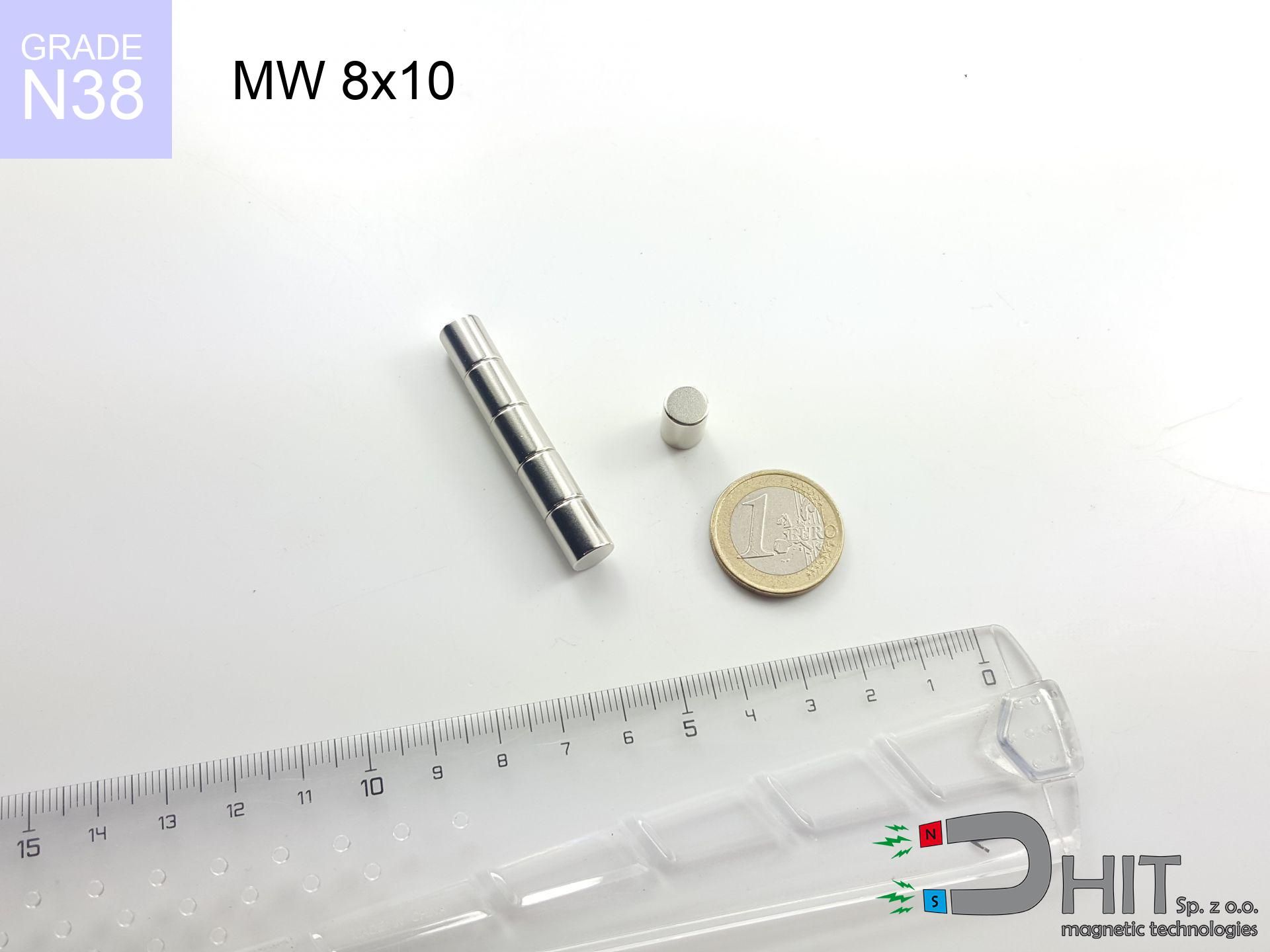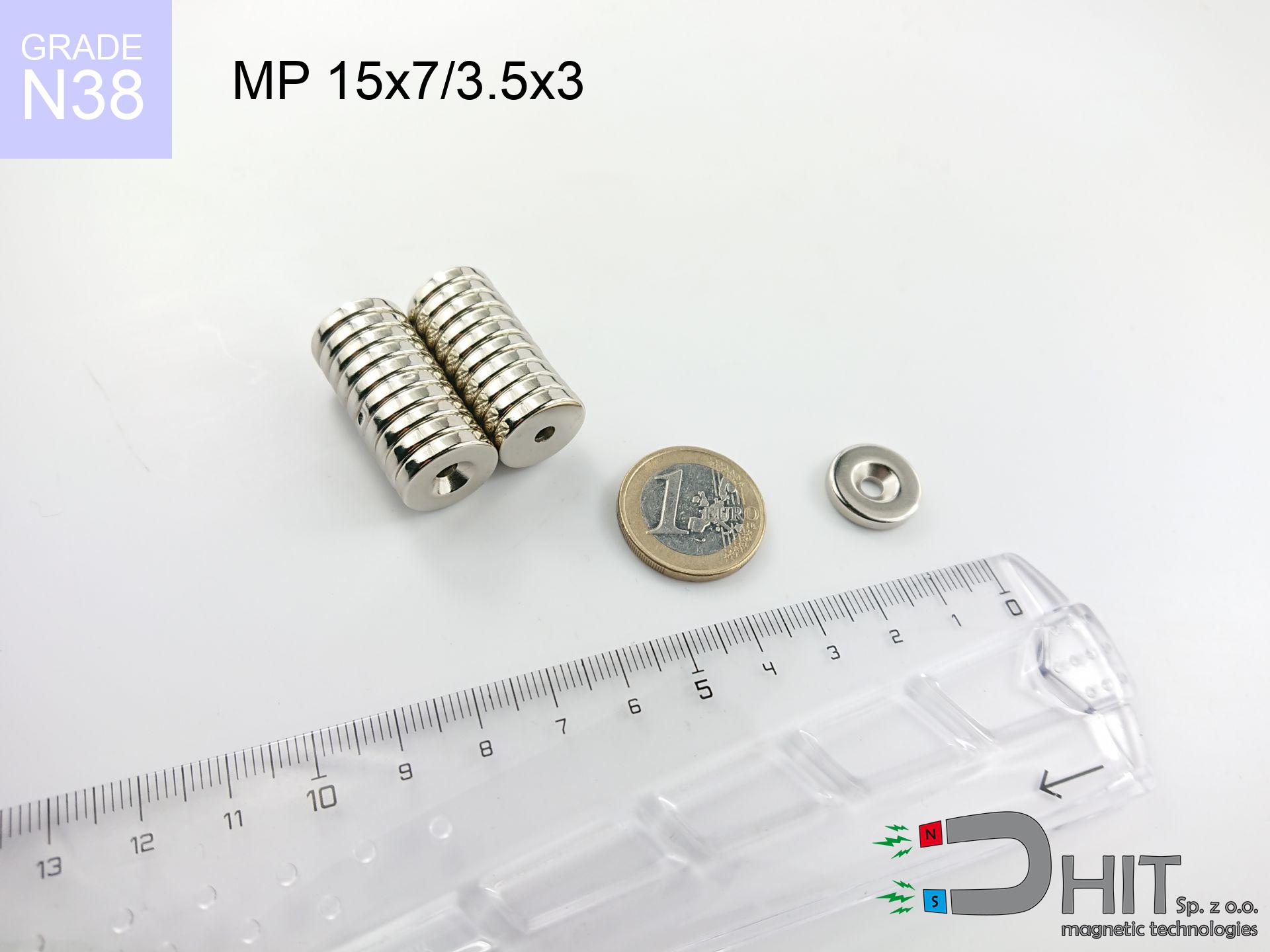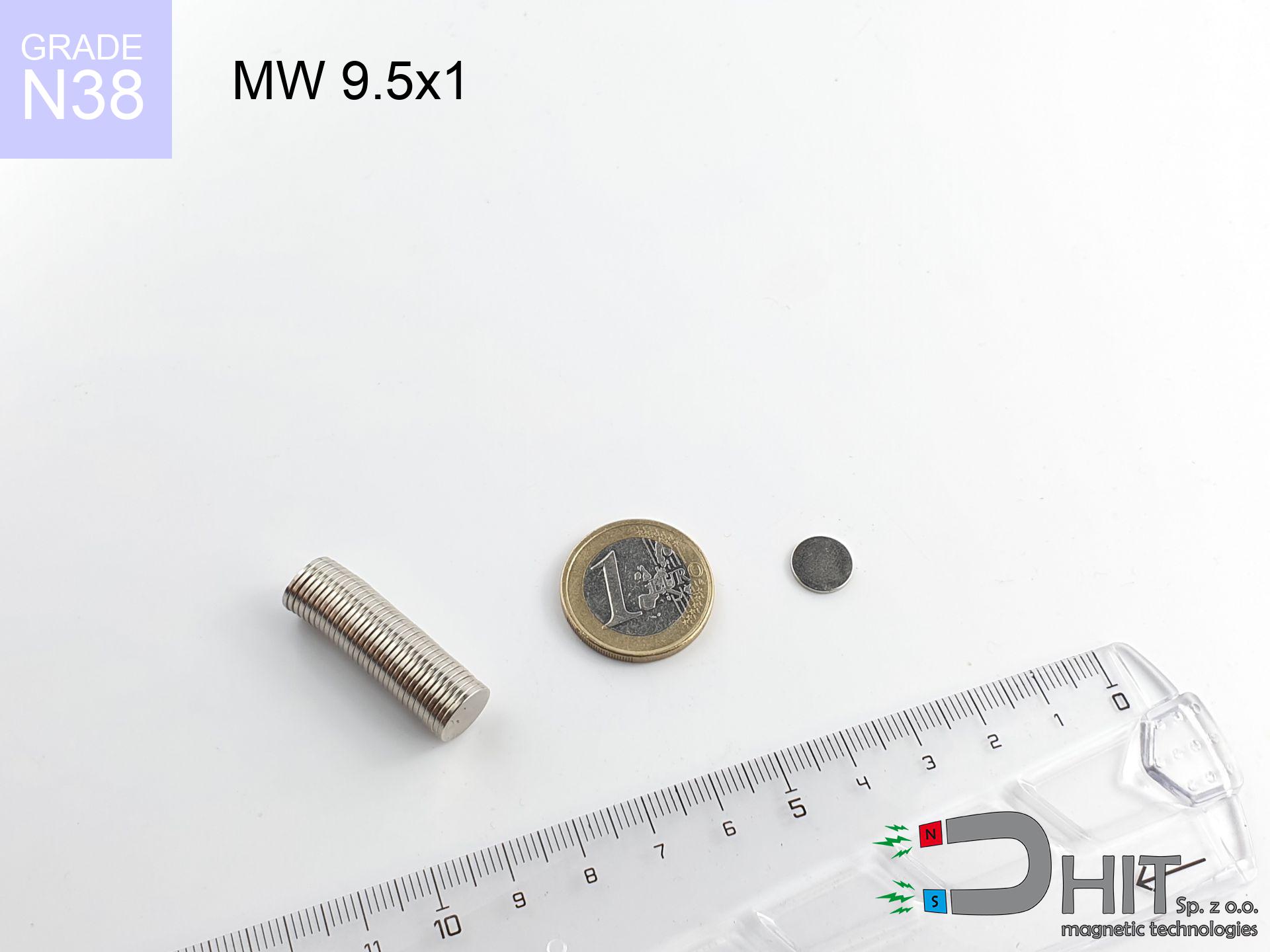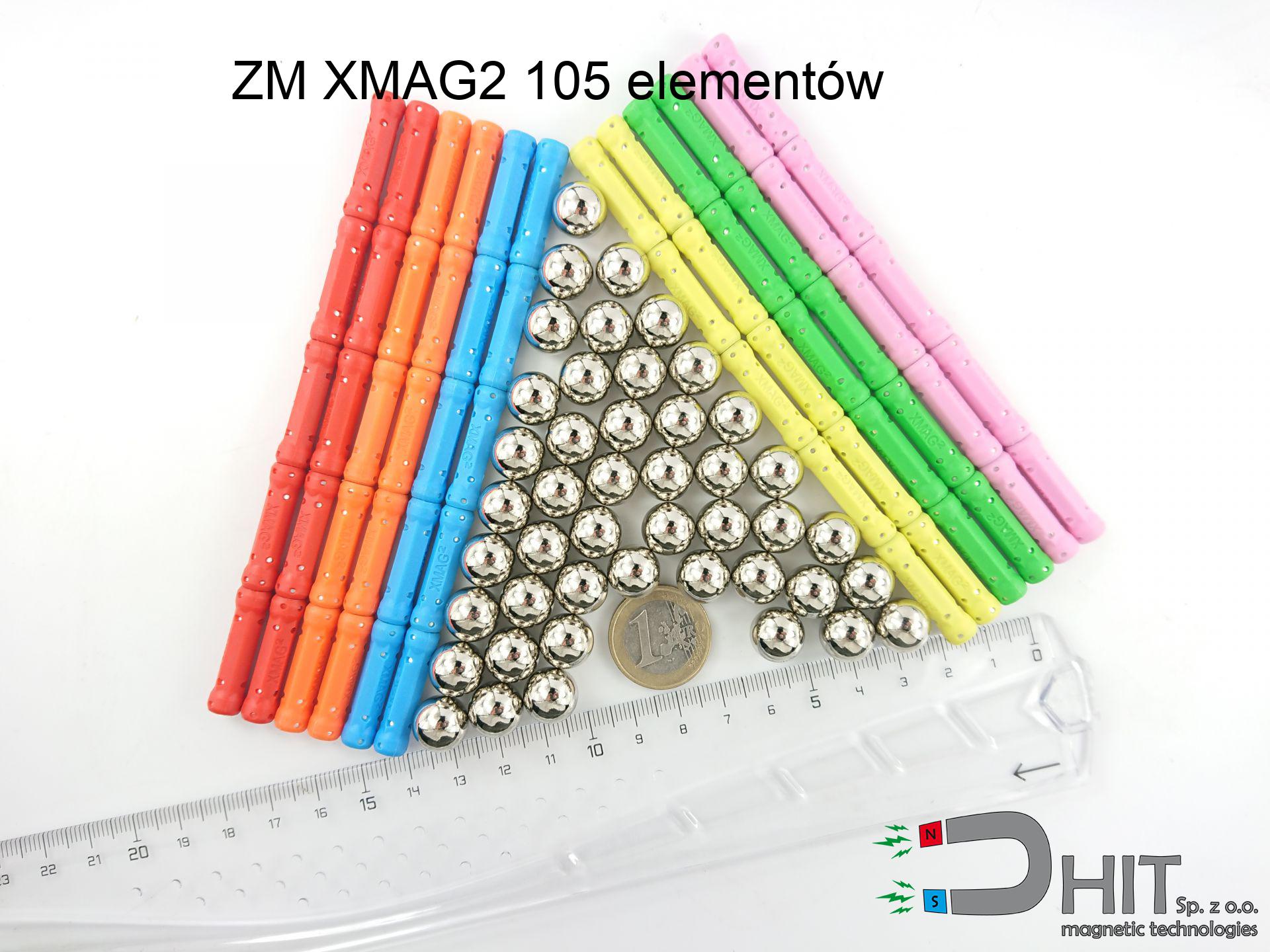MW 8x10 / N38 - cylindrical magnet
cylindrical magnet
Catalog no 010504
GTIN/EAN: 5906301814993
Diameter Ø
8 mm [±0,1 mm]
Height
10 mm [±0,1 mm]
Weight
3.77 g
Magnetization Direction
↑ axial
Load capacity
1.84 kg / 18.00 N
Magnetic Induction
574.74 mT / 5747 Gs
Coating
[NiCuNi] Nickel
1.501 ZŁ with VAT / pcs + price for transport
1.220 ZŁ net + 23% VAT / pcs
bulk discounts:
Need more?
Give us a call
+48 888 99 98 98
if you prefer send us a note using
inquiry form
the contact section.
Specifications and shape of magnets can be verified with our
our magnetic calculator.
Same-day processing for orders placed before 14:00.
Technical data of the product - MW 8x10 / N38 - cylindrical magnet
Specification / characteristics - MW 8x10 / N38 - cylindrical magnet
| properties | values |
|---|---|
| Cat. no. | 010504 |
| GTIN/EAN | 5906301814993 |
| Production/Distribution | Dhit sp. z o.o. |
| Country of origin | Poland / China / Germany |
| Customs code | 85059029 |
| Diameter Ø | 8 mm [±0,1 mm] |
| Height | 10 mm [±0,1 mm] |
| Weight | 3.77 g |
| Magnetization Direction | ↑ axial |
| Load capacity ~ ? | 1.84 kg / 18.00 N |
| Magnetic Induction ~ ? | 574.74 mT / 5747 Gs |
| Coating | [NiCuNi] Nickel |
| Manufacturing Tolerance | ±0.1 mm |
Magnetic properties of material N38
| properties | values | units |
|---|---|---|
| remenance Br [min. - max.] ? | 12.2-12.6 | kGs |
| remenance Br [min. - max.] ? | 1220-1260 | mT |
| coercivity bHc ? | 10.8-11.5 | kOe |
| coercivity bHc ? | 860-915 | kA/m |
| actual internal force iHc | ≥ 12 | kOe |
| actual internal force iHc | ≥ 955 | kA/m |
| energy density [min. - max.] ? | 36-38 | BH max MGOe |
| energy density [min. - max.] ? | 287-303 | BH max KJ/m |
| max. temperature ? | ≤ 80 | °C |
Physical properties of sintered neodymium magnets Nd2Fe14B at 20°C
| properties | values | units |
|---|---|---|
| Vickers hardness | ≥550 | Hv |
| Density | ≥7.4 | g/cm3 |
| Curie Temperature TC | 312 - 380 | °C |
| Curie Temperature TF | 593 - 716 | °F |
| Specific resistance | 150 | μΩ⋅cm |
| Bending strength | 250 | MPa |
| Compressive strength | 1000~1100 | MPa |
| Thermal expansion parallel (∥) to orientation (M) | (3-4) x 10-6 | °C-1 |
| Thermal expansion perpendicular (⊥) to orientation (M) | -(1-3) x 10-6 | °C-1 |
| Young's modulus | 1.7 x 104 | kg/mm² |
Physical modeling of the product - report
The following data represent the direct effect of a mathematical simulation. Values were calculated on models for the class Nd2Fe14B. Operational parameters may differ from theoretical values. Please consider these data as a supplementary guide during assembly planning.
Table 1: Static pull force (pull vs distance) - interaction chart
MW 8x10 / N38
| Distance (mm) | Induction (Gauss) / mT | Pull Force (kg/lbs/g/N) | Risk Status |
|---|---|---|---|
| 0 mm |
5742 Gs
574.2 mT
|
1.84 kg / 4.06 lbs
1840.0 g / 18.1 N
|
safe |
| 1 mm |
4323 Gs
432.3 mT
|
1.04 kg / 2.30 lbs
1043.0 g / 10.2 N
|
safe |
| 2 mm |
3109 Gs
310.9 mT
|
0.54 kg / 1.19 lbs
539.5 g / 5.3 N
|
safe |
| 3 mm |
2206 Gs
220.6 mT
|
0.27 kg / 0.60 lbs
271.6 g / 2.7 N
|
safe |
| 5 mm |
1149 Gs
114.9 mT
|
0.07 kg / 0.16 lbs
73.7 g / 0.7 N
|
safe |
| 10 mm |
323 Gs
32.3 mT
|
0.01 kg / 0.01 lbs
5.8 g / 0.1 N
|
safe |
| 15 mm |
131 Gs
13.1 mT
|
0.00 kg / 0.00 lbs
1.0 g / 0.0 N
|
safe |
| 20 mm |
66 Gs
6.6 mT
|
0.00 kg / 0.00 lbs
0.2 g / 0.0 N
|
safe |
| 30 mm |
24 Gs
2.4 mT
|
0.00 kg / 0.00 lbs
0.0 g / 0.0 N
|
safe |
| 50 mm |
6 Gs
0.6 mT
|
0.00 kg / 0.00 lbs
0.0 g / 0.0 N
|
safe |
Table 2: Slippage force (vertical surface)
MW 8x10 / N38
| Distance (mm) | Friction coefficient | Pull Force (kg/lbs/g/N) |
|---|---|---|
| 0 mm | Stal (~0.2) |
0.37 kg / 0.81 lbs
368.0 g / 3.6 N
|
| 1 mm | Stal (~0.2) |
0.21 kg / 0.46 lbs
208.0 g / 2.0 N
|
| 2 mm | Stal (~0.2) |
0.11 kg / 0.24 lbs
108.0 g / 1.1 N
|
| 3 mm | Stal (~0.2) |
0.05 kg / 0.12 lbs
54.0 g / 0.5 N
|
| 5 mm | Stal (~0.2) |
0.01 kg / 0.03 lbs
14.0 g / 0.1 N
|
| 10 mm | Stal (~0.2) |
0.00 kg / 0.00 lbs
2.0 g / 0.0 N
|
| 15 mm | Stal (~0.2) |
0.00 kg / 0.00 lbs
0.0 g / 0.0 N
|
| 20 mm | Stal (~0.2) |
0.00 kg / 0.00 lbs
0.0 g / 0.0 N
|
| 30 mm | Stal (~0.2) |
0.00 kg / 0.00 lbs
0.0 g / 0.0 N
|
| 50 mm | Stal (~0.2) |
0.00 kg / 0.00 lbs
0.0 g / 0.0 N
|
Table 3: Wall mounting (shearing) - vertical pull
MW 8x10 / N38
| Surface type | Friction coefficient / % Mocy | Max load (kg/lbs/g/N) |
|---|---|---|
| Raw steel |
µ = 0.3
30% Nominalnej Siły
|
0.55 kg / 1.22 lbs
552.0 g / 5.4 N
|
| Painted steel (standard) |
µ = 0.2
20% Nominalnej Siły
|
0.37 kg / 0.81 lbs
368.0 g / 3.6 N
|
| Oily/slippery steel |
µ = 0.1
10% Nominalnej Siły
|
0.18 kg / 0.41 lbs
184.0 g / 1.8 N
|
| Magnet with anti-slip rubber |
µ = 0.5
50% Nominalnej Siły
|
0.92 kg / 2.03 lbs
920.0 g / 9.0 N
|
Table 4: Material efficiency (substrate influence) - power losses
MW 8x10 / N38
| Steel thickness (mm) | % power | Real pull force (kg/lbs/g/N) |
|---|---|---|
| 0.5 mm |
|
0.18 kg / 0.41 lbs
184.0 g / 1.8 N
|
| 1 mm |
|
0.46 kg / 1.01 lbs
460.0 g / 4.5 N
|
| 2 mm |
|
0.92 kg / 2.03 lbs
920.0 g / 9.0 N
|
| 3 mm |
|
1.38 kg / 3.04 lbs
1380.0 g / 13.5 N
|
| 5 mm |
|
1.84 kg / 4.06 lbs
1840.0 g / 18.1 N
|
| 10 mm |
|
1.84 kg / 4.06 lbs
1840.0 g / 18.1 N
|
| 11 mm |
|
1.84 kg / 4.06 lbs
1840.0 g / 18.1 N
|
| 12 mm |
|
1.84 kg / 4.06 lbs
1840.0 g / 18.1 N
|
Table 5: Thermal resistance (stability) - power drop
MW 8x10 / N38
| Ambient temp. (°C) | Power loss | Remaining pull (kg/lbs/g/N) | Status |
|---|---|---|---|
| 20 °C | 0.0% |
1.84 kg / 4.06 lbs
1840.0 g / 18.1 N
|
OK |
| 40 °C | -2.2% |
1.80 kg / 3.97 lbs
1799.5 g / 17.7 N
|
OK |
| 60 °C | -4.4% |
1.76 kg / 3.88 lbs
1759.0 g / 17.3 N
|
OK |
| 80 °C | -6.6% |
1.72 kg / 3.79 lbs
1718.6 g / 16.9 N
|
|
| 100 °C | -28.8% |
1.31 kg / 2.89 lbs
1310.1 g / 12.9 N
|
Table 6: Two magnets (attraction) - field range
MW 8x10 / N38
| Gap (mm) | Attraction (kg/lbs) (N-S) | Shear Strength (kg/lbs/g/N) | Repulsion (kg/lbs) (N-N) |
|---|---|---|---|
| 0 mm |
10.22 kg / 22.52 lbs
6 064 Gs
|
1.53 kg / 3.38 lbs
1532 g / 15.0 N
|
N/A |
| 1 mm |
7.82 kg / 17.25 lbs
10 050 Gs
|
1.17 kg / 2.59 lbs
1174 g / 11.5 N
|
7.04 kg / 15.52 lbs
~0 Gs
|
| 2 mm |
5.79 kg / 12.77 lbs
8 646 Gs
|
0.87 kg / 1.92 lbs
869 g / 8.5 N
|
5.21 kg / 11.49 lbs
~0 Gs
|
| 3 mm |
4.19 kg / 9.25 lbs
7 358 Gs
|
0.63 kg / 1.39 lbs
629 g / 6.2 N
|
3.77 kg / 8.32 lbs
~0 Gs
|
| 5 mm |
2.13 kg / 4.69 lbs
5 238 Gs
|
0.32 kg / 0.70 lbs
319 g / 3.1 N
|
1.91 kg / 4.22 lbs
~0 Gs
|
| 10 mm |
0.41 kg / 0.90 lbs
2 299 Gs
|
0.06 kg / 0.14 lbs
61 g / 0.6 N
|
0.37 kg / 0.81 lbs
~0 Gs
|
| 20 mm |
0.03 kg / 0.07 lbs
646 Gs
|
0.00 kg / 0.01 lbs
5 g / 0.0 N
|
0.03 kg / 0.06 lbs
~0 Gs
|
| 50 mm |
0.00 kg / 0.00 lbs
76 Gs
|
0.00 kg / 0.00 lbs
0 g / 0.0 N
|
0.00 kg / 0.00 lbs
~0 Gs
|
| 60 mm |
0.00 kg / 0.00 lbs
47 Gs
|
0.00 kg / 0.00 lbs
0 g / 0.0 N
|
0.00 kg / 0.00 lbs
~0 Gs
|
| 70 mm |
0.00 kg / 0.00 lbs
31 Gs
|
0.00 kg / 0.00 lbs
0 g / 0.0 N
|
0.00 kg / 0.00 lbs
~0 Gs
|
| 80 mm |
0.00 kg / 0.00 lbs
22 Gs
|
0.00 kg / 0.00 lbs
0 g / 0.0 N
|
0.00 kg / 0.00 lbs
~0 Gs
|
| 90 mm |
0.00 kg / 0.00 lbs
16 Gs
|
0.00 kg / 0.00 lbs
0 g / 0.0 N
|
0.00 kg / 0.00 lbs
~0 Gs
|
| 100 mm |
0.00 kg / 0.00 lbs
12 Gs
|
0.00 kg / 0.00 lbs
0 g / 0.0 N
|
0.00 kg / 0.00 lbs
~0 Gs
|
Table 7: Protective zones (electronics) - precautionary measures
MW 8x10 / N38
| Object / Device | Limit (Gauss) / mT | Safe distance |
|---|---|---|
| Pacemaker | 5 Gs (0.5 mT) | 5.5 cm |
| Hearing aid | 10 Gs (1.0 mT) | 4.5 cm |
| Mechanical watch | 20 Gs (2.0 mT) | 3.5 cm |
| Mobile device | 40 Gs (4.0 mT) | 2.5 cm |
| Car key | 50 Gs (5.0 mT) | 2.5 cm |
| Payment card | 400 Gs (40.0 mT) | 1.0 cm |
| HDD hard drive | 600 Gs (60.0 mT) | 1.0 cm |
Table 8: Dynamics (cracking risk) - collision effects
MW 8x10 / N38
| Start from (mm) | Speed (km/h) | Energy (J) | Predicted outcome |
|---|---|---|---|
| 10 mm |
22.32 km/h
(6.20 m/s)
|
0.07 J | |
| 30 mm |
38.59 km/h
(10.72 m/s)
|
0.22 J | |
| 50 mm |
49.82 km/h
(13.84 m/s)
|
0.36 J | |
| 100 mm |
70.46 km/h
(19.57 m/s)
|
0.72 J |
Table 9: Coating parameters (durability)
MW 8x10 / N38
| Technical parameter | Value / Description |
|---|---|
| Coating type | [NiCuNi] Nickel |
| Layer structure | Nickel - Copper - Nickel |
| Layer thickness | 10-20 µm |
| Salt spray test (SST) ? | 24 h |
| Recommended environment | Indoors only (dry) |
Table 10: Construction data (Pc)
MW 8x10 / N38
| Parameter | Value | SI Unit / Description |
|---|---|---|
| Magnetic Flux | 3 040 Mx | 30.4 µWb |
| Pc Coefficient | 1.00 | High (Stable) |
Table 11: Hydrostatics and buoyancy
MW 8x10 / N38
| Environment | Effective steel pull | Effect |
|---|---|---|
| Air (land) | 1.84 kg | Standard |
| Water (riverbed) |
2.11 kg
(+0.27 kg buoyancy gain)
|
+14.5% |
1. Wall mount (shear)
*Warning: On a vertical wall, the magnet holds merely ~20% of its perpendicular strength.
2. Plate thickness effect
*Thin metal sheet (e.g. computer case) drastically reduces the holding force.
3. Power loss vs temp
*For N38 material, the safety limit is 80°C.
4. Demagnetization curve and operating point (B-H)
chart generated for the permeance coefficient Pc (Permeance Coefficient) = 1.00
This simulation demonstrates the magnetic stability of the selected magnet under specific geometric conditions. The solid red line represents the demagnetization curve (material potential), while the dashed blue line is the load line based on the magnet's geometry. The Pc (Permeance Coefficient), also known as the load line slope, is a dimensionless value that describes the relationship between the magnet's shape and its magnetic stability. The intersection of these two lines (the black dot) is the operating point — it determines the actual magnetic flux density generated by the magnet in this specific configuration. A higher Pc value means the magnet is more 'slender' (tall relative to its area), resulting in a higher operating point and better resistance to irreversible demagnetization caused by external fields or temperature. A value of 0.42 is relatively low (typical for flat magnets), meaning the operating point is closer to the 'knee' of the curve — caution is advised when operating at temperatures near the maximum limit to avoid strength loss.
Material specification
| iron (Fe) | 64% – 68% |
| neodymium (Nd) | 29% – 32% |
| boron (B) | 1.1% – 1.2% |
| dysprosium (Dy) | 0.5% – 2.0% |
| coating (Ni-Cu-Ni) | < 0.05% |
Ecology and recycling (GPSR)
| recyclability (EoL) | 100% |
| recycled raw materials | ~10% (pre-cons) |
| carbon footprint | low / zredukowany |
| waste code (EWC) | 16 02 16 |
See also products
Pros as well as cons of neodymium magnets.
Pros
- They have unchanged lifting capacity, and over around ten years their attraction force decreases symbolically – ~1% (in testing),
- They do not lose their magnetic properties even under external field action,
- The use of an metallic coating of noble metals (nickel, gold, silver) causes the element to present itself better,
- The surface of neodymium magnets generates a intense magnetic field – this is one of their assets,
- Due to their durability and thermal resistance, neodymium magnets can operate (depending on the form) even at high temperatures reaching 230°C or more...
- In view of the possibility of accurate shaping and adaptation to unique projects, NdFeB magnets can be produced in a variety of forms and dimensions, which makes them more universal,
- Universal use in modern industrial fields – they find application in computer drives, brushless drives, advanced medical instruments, as well as other advanced devices.
- Thanks to their power density, small magnets offer high operating force, with minimal size,
Disadvantages
- At very strong impacts they can break, therefore we advise placing them in strong housings. A metal housing provides additional protection against damage and increases the magnet's durability.
- Neodymium magnets decrease their power under the influence of heating. As soon as 80°C is exceeded, many of them start losing their force. Therefore, we recommend our special magnets marked [AH], which maintain durability even at temperatures up to 230°C
- Magnets exposed to a humid environment can corrode. Therefore when using outdoors, we suggest using water-impermeable magnets made of rubber, plastic or other material protecting against moisture
- We recommend a housing - magnetic mount, due to difficulties in producing threads inside the magnet and complicated shapes.
- Potential hazard related to microscopic parts of magnets pose a threat, if swallowed, which gains importance in the aspect of protecting the youngest. Additionally, small elements of these devices are able to disrupt the diagnostic process medical after entering the body.
- With large orders the cost of neodymium magnets can be a barrier,
Pull force analysis
Best holding force of the magnet in ideal parameters – what affects it?
- with the contact of a yoke made of special test steel, ensuring maximum field concentration
- whose transverse dimension is min. 10 mm
- with an ground contact surface
- under conditions of gap-free contact (metal-to-metal)
- under vertical force direction (90-degree angle)
- at ambient temperature approx. 20 degrees Celsius
Key elements affecting lifting force
- Space between magnet and steel – every millimeter of separation (caused e.g. by veneer or unevenness) diminishes the magnet efficiency, often by half at just 0.5 mm.
- Load vector – maximum parameter is obtained only during pulling at a 90° angle. The force required to slide of the magnet along the plate is typically many times smaller (approx. 1/5 of the lifting capacity).
- Plate thickness – insufficiently thick sheet does not close the flux, causing part of the flux to be escaped to the other side.
- Material composition – not every steel attracts identically. High carbon content worsen the attraction effect.
- Plate texture – smooth surfaces guarantee perfect abutment, which improves field saturation. Uneven metal reduce efficiency.
- Thermal environment – heating the magnet causes a temporary drop of induction. Check the thermal limit for a given model.
Holding force was measured on the plate surface of 20 mm thickness, when the force acted perpendicularly, whereas under parallel forces the lifting capacity is smaller. In addition, even a small distance between the magnet and the plate reduces the load capacity.
H&S for magnets
Operating temperature
Standard neodymium magnets (grade N) lose power when the temperature surpasses 80°C. Damage is permanent.
Phone sensors
Remember: neodymium magnets generate a field that confuses sensitive sensors. Keep a safe distance from your phone, device, and GPS.
Dust is flammable
Fire warning: Neodymium dust is explosive. Do not process magnets in home conditions as this risks ignition.
Nickel allergy
Some people suffer from a sensitization to nickel, which is the standard coating for NdFeB magnets. Extended handling can result in an allergic reaction. We recommend use protective gloves.
Do not give to children
Strictly store magnets out of reach of children. Risk of swallowing is significant, and the consequences of magnets clamping inside the body are fatal.
Do not underestimate power
Handle with care. Rare earth magnets act from a long distance and connect with massive power, often faster than you can move away.
Pacemakers
Warning for patients: Strong magnetic fields disrupt medical devices. Maintain minimum 30 cm distance or ask another person to handle the magnets.
Beware of splinters
NdFeB magnets are sintered ceramics, which means they are very brittle. Collision of two magnets leads to them cracking into shards.
Data carriers
Do not bring magnets near a wallet, computer, or TV. The magnetism can permanently damage these devices and erase data from cards.
Hand protection
Risk of injury: The pulling power is so great that it can cause hematomas, pinching, and broken bones. Protective gloves are recommended.








